The New Rules of Engagement Global Employee Inspiration research report
Written by: Mark Hirschfeld, VP, Consulting Services and Strategic Partnerships; Rob Mezera, Research Director, Research and Strategy; Amy Stern, Managing Director, Research and Strategy
(View Author Bio)
Of those who score highly on The New Rules of Engagement®, 70% are highly committed, 91% are giving high effort, and 95% are feeling inspired at work.

Foreword
Employees are at the heart of every company.
They make the company run and they are the reason any company exists. While all companies have unique challenges, there are three around employees that resonate across all of BI WORLDWIDE’s clients:
1. Employee Commitment:
How can we attract more people to our company and encourage them to stay with us?
2. Employee Effort:
How can we motivate our employees to work hard for the company and most importantly, our customers?
3. Employee Inspiration:
Beyond just working hard, how can we inspire our employees to bring their best ideas to work, think in new and different ways and innovate?
These questions are where BI WORLDWIDE’s research comes in. Every year, we conduct research to benchmark and understand the latest trends in the work experience that directly lead to these three outcomes. Our 2023 research focused on a representative sample of employees at companies with 1,000 employees or more across 18 countries on five continents. Respondents spanned 18 industries including healthcare, consumer goods and services, technology, transportation and finance.
At the core of this research is The New Rules of Engagement®, BIW's proprietary model, which identifies what companies can offer to employees to best encourage them to stay, work hard and feel inspired at work. We update the benchmarks on our existing model annually and continue to test new concepts. We listen to what our clients are experiencing and update our research accordingly.
____________________
Amy Stern, Managing Director, Research and Strategy
____________________
The New Rules of Engagement®
This year, we explored trends including talent mobility, culture, ESG, inflationary pressures, disparity between leaders and the front lines, mentorship, onboarding, inclusive leadership, remote work, deskless employees, manager enablement, wellbeing, mental health and more.
Not all these trends can fit into one report, so we did a deeper dive into a few of them: onboarding, talent mobility, recognition, belonging, deskless employees and eNPS. The research around these trends can help address the challenges around commitment, effort and inspiration in a company.
____________________
____________________
Onboarding
Help employees get off to a great start.
It takes a lot of time, effort and money to onboard a new employee. And over a third of new hires surveyed stated they’re planning to leave their companies in the next year. Knowing what it takes to onboard a new hire, it’s important that you create a positive onboarding experience.
New hires rarely remember what they learned on their first day, but they do remember how they felt. We have found ten best practices across eight themes that will help new hires stay with their companies. Employees who experienced a majority of those were most likely to stay, with only 4% stating they were planning to leave in the next 12 months. However, new hires who only experienced three or fewer of these best practices were already looking for their exit – 58% were planning to leave in the next 12 months.
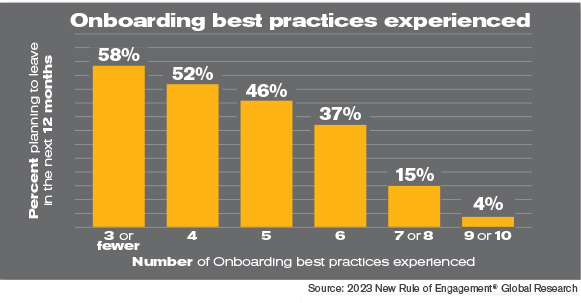
So what are these themes that make a new hire want to stay?
1. Build excitement for Day 1
2. Introduce them to others
3. Teach about the job on Day 1
4. Keep Day 1 active
5. Provide a challenge
6. Support mistakes
7. Show them their future
8. Connect them to the purpose
When you give new hires these experiences over their first days, weeks and months, they feel like they belong and are part of the company. They stay active instead of wondering how to fill their days, and they are supported by their team and manager.
Recognition is also a big part of onboarding as it helps your company retain the new hires that you’ve invested time and energy in. When you remind new hires of how they impact the mission of the company, they are 2 times more likely to want to stay with the company. To make an even bigger impact, personalize the recognition. Employees who are more connected to their managers are 5.7 times more likely to feel inspired at work.
During their onboarding journey, new hires will start hitting key milestones, and these are perfect times to recognize them. Recognizing service anniversaries is simple. However, only 53% of new hires had their 1- or 3-year anniversary celebrated. New hires who don’t get this early recognition were twice as likely to be job searching in the past month. There are many positions that would benefit from even earlier recognition at increments of 30 days, 90 days or six months.
An employee’s experience at your company is a journey, just like the process of supporting them. Make sure you’re constantly auditing and reworking your onboarding process to meet the needs of your workforce. When new hires are supported from Day 1, they get up to speed faster, stay longer and are more inspired by their organization.
Your action steps:
1. Define your key audiences and evaluate the onboarding journey for each of them.
2. Follow the general onboarding best practices including creating excitement prior to the first day, making the first day interactive and informative and ensuring employees are challenged and supported while seeing their career path through their first year.
3. Gain feedback from your employees through onboarding surveys to understand best practices that may be more applicable to your company of certain job positions.
4. Recognize employees at key points in their onboarding journey and when they are impacting the company's goals and purpose.
____________________
Benjamin Kjos, Sr. Creative Director, Communications
____________________
Talent mobility
Support each employee in preparing for and seeing a future that works for them (and you).
__________
"The company does poorly regarding promoting from within. We had internal candidates who could have stepped in and done the job quite nicely."
"There was no clear direction for those who didn't know what they wanted to do. Clearly defined career paths were not available."
"There is not much opportunity to move up. You get entrenched in a position and you're stuck there."
__________
As shown in these comments, respondents in The New Rules of Engagement® survey were often frustrated when they faced barriers to their talent mobility. Talent mobility is the idea that employees will have the ability to find new job opportunities within their company. The participants that made these comments didn’t feel like they had the opportunity to advance and grow with their employer and they’re much more likely to find a new company who will support their career aspirations and goals.
Employees want to see their future with their company, and it’s a huge driver of employee commitment. Companies who understand the dynamics of career growth can create a culture that not only promotes upward mobility but also values and encourages personal growth and lateral moves. In fact, our research shows that the journey is just as important as the destination.
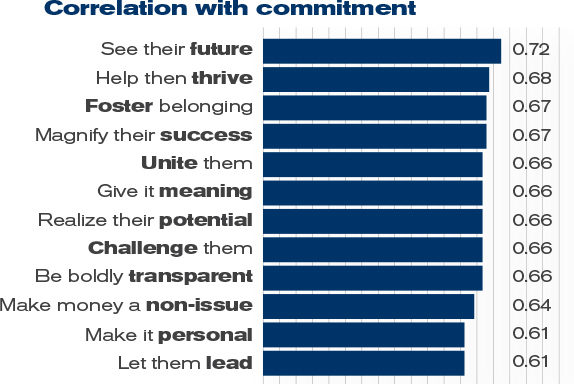
Promotions are a common goal for employees, but the journey to get there is equally important to their development and engagement. Employees who receive training and development opportunities that could further their career are more than twice as likely to be engaged in their work than those not receiving those opportunities.
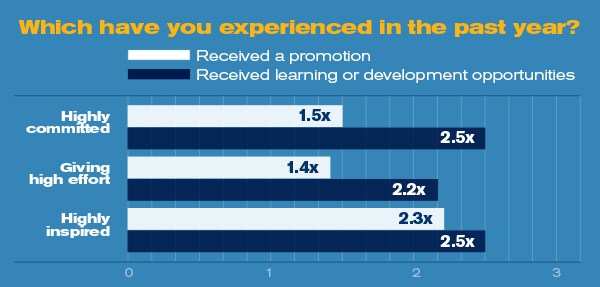
It’s important to give employees the skills they need to do their jobs well, but to make more of an impact, you need to enable employees to develop in ways that are meaningful to them. Companies that empower their employees with the ability to shape their development paths have employees that are more committed, give higher effort and are more inspired.

__________
Learn more about developing skills with BIW's
__________
However, if career growth is limited to just promotions, you’re leaving a large portion of your employees with no viable options to grow. Lateral moves are often overlooked as a way to grow within a company, and these moves are essential when it comes to employee engagement. Employees who have the opportunity to make a lateral move display higher levels of overall engagement.
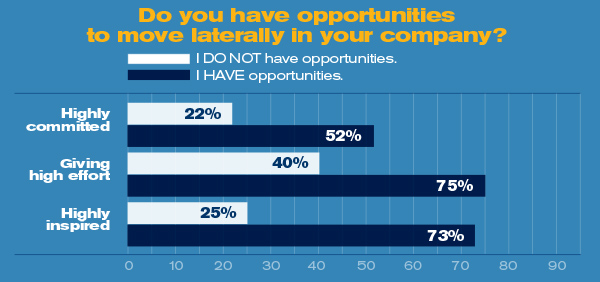
Lateral moves and personal growth aren’t celebrated often, but they are a huge part of employee satisfaction and commitment. When you acknowledge and formally celebrate lateral moves and promotions, it will improve engagement and employee net promoter scores, which means more of your talent will recommend you as a great place to work.
When you incorporate lateral moves, personalized development and frequent recognition into your career development framework, you’re much more likely to have committed, engaged and inspired employees. By embracing this holistic approach to growth, you can unlock the full potential of your employees and keep them at the company.
Your action steps:
1. Ensure employees understand all their career options within the company.
2. Learn what types of growth and development are of interest to each employee and strive to provide opportunities for ways to learn and grow that are important to them.
3. Recognize growth as it happens, not just when it's "complete." Consider incorporating both intrinsic and extrinsic rewards to drive learning activity.
4. Formally celebrate both lateral moves and promotions.
____________________
Mark Hirschfeld, Vice President, Research and Strategic Partnerships
____________________
Recognition
As employees achieve and contribute, make sure they are recognized and rewarded in ways that inspire them.
We’re all motivated by praise, but sadly, too many employees go without recognition in their work. And employees and employers alike pay a price when good work goes unrecognized. Working hard and receiving no recognition demoralizes employees and managing employees in a way that cause these attitudes can kill engagement and inspiration in the workplace. There needs to be a strategy around recognition.
Anyone who has visited a Disney® theme park understands the importance of strategy. Before you enter the park, you need to know what rides you want to hit, where they are in the park and when you want to stop to eat. You need a strategy to accomplish everything you want in your time at the park, and if you don’t have one, time slips away from you and you miss experiencing everything you wanted to.
Creating a recognition program is no different. You need to define your objectives to create a strategy so you don’t fill your days with recognition that doesn’t tie to your company goals. It’s easy to lose sight of strategy with both recognition and Disney. Everything is fun, nice and enjoyable, but just because it feels good doesn’t mean it’s achieving your goals. It’s critical to identify your recognition program’s objectives and the strategy to achieve them.
Your recognition program should reinforce your company’s mission, vision, values and goals. This reinforces the behaviors you want to see more of at work. Our research shows that when recognition specifically reinforces company values, recipients report giving greater effort and feeling more inspired than when they receive recognition without this reinforcement.

This type of recognition helps your employees connect the work they do with your company mission. Most employees value their company’s mission since missions are clear and easy to align with. However, many employees don’t see how their work connects with the company mission. Those who have received recognition around company values are four times more likely to connect with the company’s mission.
In the last few years, the workforce has become increasingly remote. With so many remote workers, the connection to your company’s mission and culture has become a bigger challenge. Fully remote workers are struggling more with feeling connected to the company culture, but when they receive recognition aligned with company values, they feel just as connected to the company culture as those who are hybrid.

Recognition’s impact does not stop here. Our research shows that recognition can impact your employees’ sense of belonging, purpose, career path, accomplishments and teamwork.

Our research shows that recognition is good, but recognition with rewards is better. The rewards efficacy continuum from Dr. Ran Kivetz, PhD, Columbia University, shows that experiences and merchandise are the most effective motivators, and our research reinforces these findings.

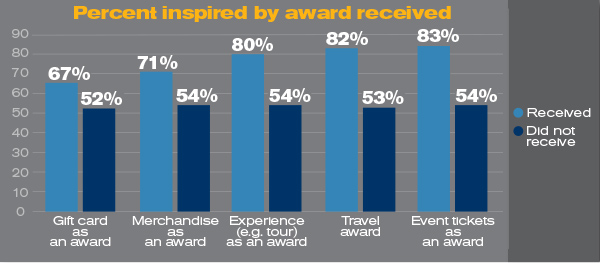
We have spent a lot of time on the benefits of receiving recognition. Employees who receive recognition from their peers report feeling happier, more motivated and more valued. Recognition does not just benefit the recipient; it also benefits the giver. Employees who give recognition report feeling even more connected to their peers than those who are receiving. Giving recognition is not just a means to someone receiving but can also provide benefits to the giver in practicing gratitude and building relationships with their colleagues.
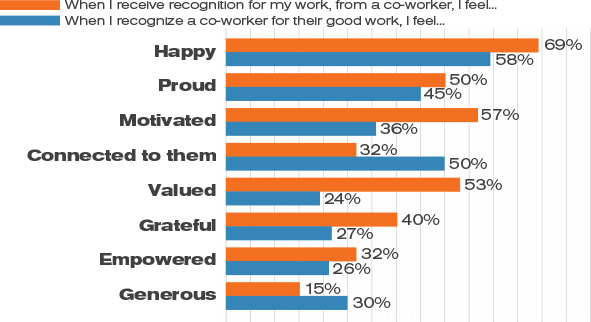
As employees are bringing more of their whole lives to work, organizations are starting to recognize milestones both at work and in their personal lives. Employees who are recognized for service anniversaries as well as major life moments like marriages, new homes and the birth of children feel more connected to their companies and are more likely to promote their company as a great place to work.
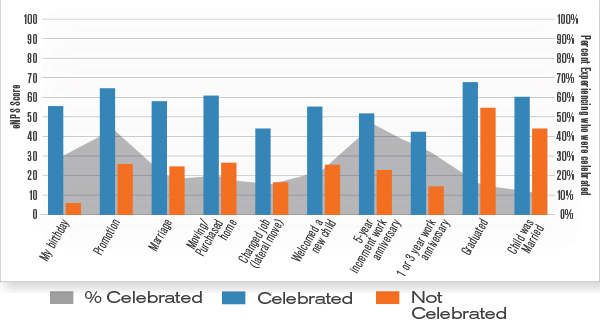
From the beginning of their journey to professional milestones to personal joys, recognizing employees in your company connects them to your mission, vision, values, culture and goals. It also helps inspire and connect employees who may turn into advocates of your company.
__________
Case study:
Financial Services
A financial services client implemented a recognition and reward program with the goal of improving performance at the retail banking level. Employees were recognized for behaviors the bank had identified as leading to better customer experiences. Based on their own data, the bank determined that branches who used the program had better employee retention and improved customer satisfaction scores. They calculated the cost of employee turnover and determined the improvements in employee retention more than paid for the program.
Retail
One of our national retail clients saw the value of recognizing employees for behaviors aligned with and supportive of their values. They looked at recognition patterns in two large regions and found that employees who received recognition aligned with company values had improved customer satisfaction and sales. Recognition is good, but recognition aligned to key behaviors is better.
__________
Your action steps:
1. Design a thoughtful, strategic recognition program that aligns to your mission, vision, values and goals.
2. Align recognition to your values to help employees feel connected to your company culture.
3. Encourage recognition giving to promote connections across your employees and increase the numbers of people receiving and feeling valued.
4. Create a goal for each employee to receive recognition monthly and recognition with rewards at least quarterly. Consider rewards that will inspire, such as travel and experiences, and give choice in rewards.
5. Strengthen existing programs by communicating to less-engaged groups about the importance of recognition. And leverage your most-engaged groups to spread recognition further throughout your company.
6. Ensure new managers, those hired from the outside, and internal employees who have been promoted, understand the value of the program and have been properly trained to use these tools.
____________________
Christina Fortier, Sr. Creative Director, Communications
____________________
Belonging
Build a workplace where everyone feels they truly belong.
A sense of belonging is the best predictor of inspiration in our research. Belonging is crucial for a thriving workplace, but it’s challenging to influence without understanding what belonging really means. The New Rules of Engagement® survey found that there are 12 facets of work that are important to promote a sense of belonging:
1. Strong sense of teamwork
2. Confidence good work will be recognized
3. Manager understands me
4. Opportunities to develop skills
5. Trusted with important decisions
6. Able to bring my full self to work
7. Organization is open-minded
8. Personally connected to mission, vision and values
9. Organization supports my wellbeing
10. Optimistic about my future here
11. Leaders listen to employee needs
12. Able to accomplish more here than elsewhere
A key aspect of belonging is having a manager that understands their employees. When employees have inclusive leaders, they are 10 times more likely to feel a sense of belonging at work and 12 times more likely to find their work inspiring. And managers understand this. 88% of managers want to be equitable and inclusive. Despite good intentions, only 52% of employees rate their managers as equitable and inclusive. Managers need help moving from wanting to do the right thing to actually changing their behaviors. Companies can support managers by making inclusive leadership easier.
To help with this transformation, BIW’s Inclusive Leadership Index offers managers actionable feedback on areas that need improvement. Companies can support managers by implementing systems and processes that encourage inclusive practices.
Inclusive managers exhibit behaviors such as:
-
Listening to everyone on the team
-
Providing unbiased feedback
-
Evaluating team members with consistent criteria
-
Understanding employees
-
Dividing work according to abilities
-
Making decisions with employees' interests in mind
-
Recognizing good work
-
Understanding and advicating for principles of DE&I
Recognition is a critical factor in both the Inclusion Index and Inclusive Leadership Index. Fair and consistent recognition significantly contributes to fostering a sense of belonging among individuals.
Fair and consistent recognition impacts the sense of belonging
Increased odds |
I belong at my organization |
I am confident that if I do good work, it will be recognized. |
7.5x |
Recognition is provided fairly across my organization. |
7.4x |
I have received incredible recognition in my current job. |
6.8x |
My manager tells me when I do a good job. |
6.6x |
Cultivating a culture of belonging requires listening, strategy and intentional actions. By understanding and addressing the intricacies of belonging, fostering inclusive leadership, emphasizing recognition of inclusive behaviors and showing employees they are valued, companies can unlock a culture of belonging.
Your action steps:
1. Understand strengths and opportunities in belonging at your organization.
2. Ensure managers know what they need to do to be inclusive by customizing activities based on where managers have room to improve.
3. Recognize inclusive behaviors to ensure they get repeated.
4. Recognize employees to help them feel valued at work.
____________________
Sami Foust, Creative Director, Communications
____________________
Deskless employees
Have "deskless" employees? Ignore them at your own risk.
Who exactly are deskless employees? You may not have heard the term before, but you probably worked at a deskless job at least once. These are the employees in roles that don’t spend a majority of their time behind a desk or at a computer like retail, warehouse and restaurant workers. These employees have been referred to as “essential employees” or “front-line workers.”
The term “deskless” is relatively new, but these employees have been part of the conversation for years. Previously, they were referred to as “disconnected” employees, but results from The New Rules of Engagement® study show that 80% of these employees have an electronic device like a phone or tablet that allows their employer to communicate with them. Sometimes employers will provide these devices, but others have an app that employees can download on their own smartphones. Many times, these apps provide training and recognition opportunities.
But employers aren’t effectively using these apps or devices for training and recognition. Only 37% of deskless employees report receiving training on their electronic device, and only 34% receive recognition via their device.
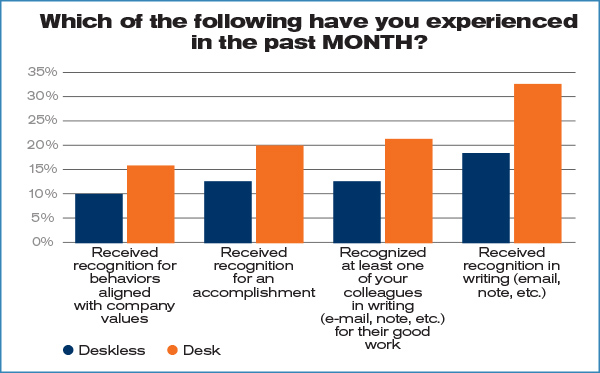
So what now? How can you engage your deskless employees? Here are six ways to bridge the communication gap, drive engagement and foster belonging in your organization.
1. Align to key business challenges
Many employers of deskless employees face challenges like industrial safety, retention, customer service and absenteeism. Recognizing and rewarding employees for positive outcomes in key areas help lessen these challenges.
2. Integrate with the electronic tools you already use
We know employees have electronic devices like their own smartphones or company-provided devices like those from Zebra Technologies. These devices and apps on smartphones provide training and recognition opportunities, so using these devices to communicate with employees will create a one-stop shop for communication, training and recognition.
3. Have an adoption strategy
Just because there’s an app available to employees doesn’t mean they actually use it. If you don’t have an adoption strategy that encourages employees to use the app, it’s time to create one. A good adoption strategy includes on-location advocates and gamification to improve participation as well as ongoing manager training and recognition.
4. Tell the story
Communicate the key elements of an initiative – safety, customer service, etc. – to drive engagement with deskless employees. Using electronic communication is important, but don’t forget offline tools like branded merchandise, displays and breakroom leaderboards.
5. Share early successes
As employees start responding to the program and results begin to improve, share the successes early and often. How can you do that? Highlight associates who hit key milestones in the program like helping a difficult customer and maintaining their business. Share successes from the manufacturing plant for a string of days with no errors. Early wins can inspire employees and reinforce ideas on how they can be successful.
6. Continue to measure success and adjust as needed
Most programs require periodic review and identification of next steps. Make adjustments in the program to foster more involvement like offering skills training at the beginning of the program and then offering advanced training as participants excel.
__________
Case study:
A client with manufacturing employees was looking for a way to keep them engaged via their mobile devices. BIW built a solution using our patented gamification platform, Bunchball Go™. The platform was designed with goals around attendance, productivity and safety, and employees could clearly see their goals, earn recognition and track their progress.
After the program was implemented, our client saw an 8% increase in the key productivity metrics they were monitoring. This was due to increased collaboration, communication and friendly competition between teams.
__________
Your action steps:
1. Measure the experience of your deskless employees to identify gaps and opportunities.
2. Align deskless employees to key business challenges.
3. Integrate deskless employees with the electronic tools that give them access.
4. Create an adoption strategy to encourage deskless employees to use the app and stay connected.
5. Communicate the elements of initiatives to drive engagement with deskless employees.
6. Share early successes to inspire deskless employees.
7. Continue to measure successes and make adjustments as needed.
____________________
Nada Mohamed, Data Analyst, Research and Strategy
____________________
eNPS
If you do these things well, you'll build a legion of committed, passionate advocates.
We’re all familiar with the Net Promoter Score (NPS) which is a measurement of customer loyalty, but companies should also pay attention to their eNPS or Employee Net Promoter Score. eNPS measures the likelihood an employee would recommend working at your company. eNPS and NPS scores fall in the same three categories of promoters (scoring a 9 or 10), passives (scoring a 7 or 8) and detractors (scoring a 6 or below). These detractors are often the employees who are unhappy and disengaged in various ways and are unlikely to recommend your company to others.
eNPS doesn’t provide the entire picture of how your employees feel, but it’s a start to get an idea of where your company is succeeding. If your company is scoring high on eNPS, you likely have a lot of promoters. Promoters will bring in great talent. And employees who were referred to the company are more likely to be more engaged and inspired at work. They’re also more likely to be promoters themselves.
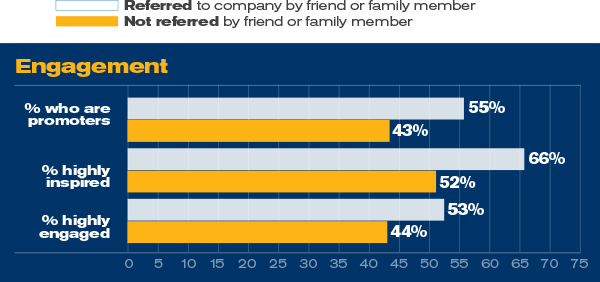
__________
How does a company create promoters? They provide an employee experience that is something they want others to share in and join, making them more likely to recommend their company. Employees who gave their company higher scores have experienced recognition for behaviors aligned with the company’s mission and values. They have been given the opportunity to have their voices heard. They are reminded they make a difference on a regular basis. Here are some other ways to help employees become promoters:
Be boldly transparent
Leadership transparency is an important part of shaping employees’ perceptions of their workplace. Engaging in active listening sessions, valuing diverse perspectives and presenting a compelling and transparent vision for the company’s future instills a sense of purpose and loyalty among employees.

Foster belonging
Create an environment where employees feel a sense of belonging. Embracing diversity and actively promoting an inclusive culture are keys to building a team of enthusiastic promoters.

Magnify their success
Foster a positive and supportive workplace culture by regularly recognizing and appreciating employees’ hard work. Recognize employees for behaviors aligned with company values, both as part of a team and individually.

Give it meaning
It’s critical to align employees with the company’s mission and values. Regular reminders of how each employee’s contributions impact the company’s mission will reinforce a sense of purpose among employees.

Realize their potential
Investing in employee development is a huge part of engagement. Providing training opportunities aligned with each employee's interests and career goals enhances their commitment to their company.

Make money a non-issue
When a company actively supports employees in achieving their long-term financial goals, employees are more loyal to their company. A competitive salary is one way to help employees reach their goals, but don’t forget that benefits and financial security contribute to employees’ overall financial wellbeing.

Help them thrive
If employees are burned out, they’re not going to be promoters of your company. To help create promoters, ensure your company is adequately staffed and there is a healthy work-life balance. With proper staffing levels, employees don’t feel the need to work even if they’re sick, have a prior commitment or need a break.

People who score highly on eNPS tend to be more committed, more engaged and provide better customer service. This means your happy employees create happy customers, and a better eNPS may lead to a better NPS. It’s important to remember that eNPS should be looked at with other metrics to ensure your employees are getting the best experience.
__________
Your action steps:
1. Encourage employees to promote the company to their network.
2. Be transparent - share the company's vision with employees.
3. Recognize employee success both personally and professionally.
4. Encourage their growth, development and wellbeing.
____________________
Amy Stern, Managing Director, Research and Strategy
____________________
Conclusion
The management guru Peter Drucker is famous for reminding leaders that “plans are only good intentions unless they immediately degenerate into hard work.”
And such is the work of engaging and inspiring employees. But it’s work that pays off immeasurably. With the insights from The New Rules of Engagement® global research, we know where we should focus that hard work:
- Make sure you’re intentional about getting new employees off to a great start, an effort that sets the stage for how they engage and align with your culture.
- Think about helping all employees, even new to the organization, see how they can develop skills and contribute to work in ways they find satisfying and offer them opportunities to grow their careers.
- Increase the sense of confidence that each employee will be recognized and rewarded for their contributions and moments that are important to them.
- Continue efforts to make sure each employee feels like they belong, inclusive of their background or experiences, and provide managers with the tools to create a genuine feeling of belonging.
- Care for deskless employees that may be more difficult to engage and inspire, such as employees in retail, manufacturing or distribution. Their contributions to the success of the organization are enormous, so provide the requisite investment.
- If we do the “hard work,” a natural result of those efforts will be more employees who will be passionate advocates, not only staying longer and working harder, but singing your praises as an employer and a provider of products and services.
This is the work. Let's get going.
____________________
BI WORLDWIDE partnered with a panel company in the United States and the panel company’s global partners to target English-speaking employees of companies with 1,000 employees or more. After completing data quality procedures, a total of 2,140 surveys were included with 1,027 of those being U.S. surveys and 1,113 being non-U.S. surveys. A total of 18 countries on five continents were represented in the surveys from 18 industries, including healthcare, consumer goods and services, technology, transportation and finance.
The data from the United States were balanced to reflect the age, gender and ethnicity of full-time U.S. employees as outlined by the Bureau of Labor Statistics. Forty-seven percent of respondents were female while 52% were male. The average respondent age in the U.S. was 43.1 years with a standard deviation of 13.4 years.
The data from non-U.S. respondents were similar, with 40% of respondents being female and 60% being male. The average age of respondents outside the United States was 39.1 with a standard deviation of 11.9 years.
Ready to get to work?














